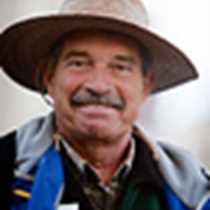Bahia Magdalena, Baja California Sur, México
Leaving the open Pacific Ocean and entering Magdalena Bay on the southwestern part of the peninsula of Baja California is an adventure. Forming the outer barrier to this huge lagoon system is Isla Margarita to the south. Immediately to its north is sickle-shaped Isla Magdalena, which measures almost 60 miles in length. At La Entrada (The Entrance) we were able to see a marvelous phenomenon among the gray whales that will hopefully lead to the continuity of the species, namely mating. Females who have not borne a calf this season will go into heat at about this time of year and interested males wait near La Entrada for any such female to pass their way.
Once inside the bay, we traveled north to our anchorage east of Bahia Santa Maria. Here we had a very interesting walk across the sandy dunes to the Pacific side, enjoying a wide variety of desert plants. Bones of different sea animals littered the western beach. As the day advanced, north was our direction once again. We completed our transit near the island’s northernmost tip. The mouth of the bay here is called “Boca de Soledad” (Mouth of Solitude). During our afternoon in the Hull Canal we saw a number of seabirds among which were magnificent frigatebirds, brown pelicans, double-crested and Brandt’s cormorants, godwits, white ibis and even falcons! But most exciting was an animal, which seemed oblivious to our presence, a well-fed coyote walking along the water’s edge in search of its next meal.
Leaving the open Pacific Ocean and entering Magdalena Bay on the southwestern part of the peninsula of Baja California is an adventure. Forming the outer barrier to this huge lagoon system is Isla Margarita to the south. Immediately to its north is sickle-shaped Isla Magdalena, which measures almost 60 miles in length. At La Entrada (The Entrance) we were able to see a marvelous phenomenon among the gray whales that will hopefully lead to the continuity of the species, namely mating. Females who have not borne a calf this season will go into heat at about this time of year and interested males wait near La Entrada for any such female to pass their way.
Once inside the bay, we traveled north to our anchorage east of Bahia Santa Maria. Here we had a very interesting walk across the sandy dunes to the Pacific side, enjoying a wide variety of desert plants. Bones of different sea animals littered the western beach. As the day advanced, north was our direction once again. We completed our transit near the island’s northernmost tip. The mouth of the bay here is called “Boca de Soledad” (Mouth of Solitude). During our afternoon in the Hull Canal we saw a number of seabirds among which were magnificent frigatebirds, brown pelicans, double-crested and Brandt’s cormorants, godwits, white ibis and even falcons! But most exciting was an animal, which seemed oblivious to our presence, a well-fed coyote walking along the water’s edge in search of its next meal.




